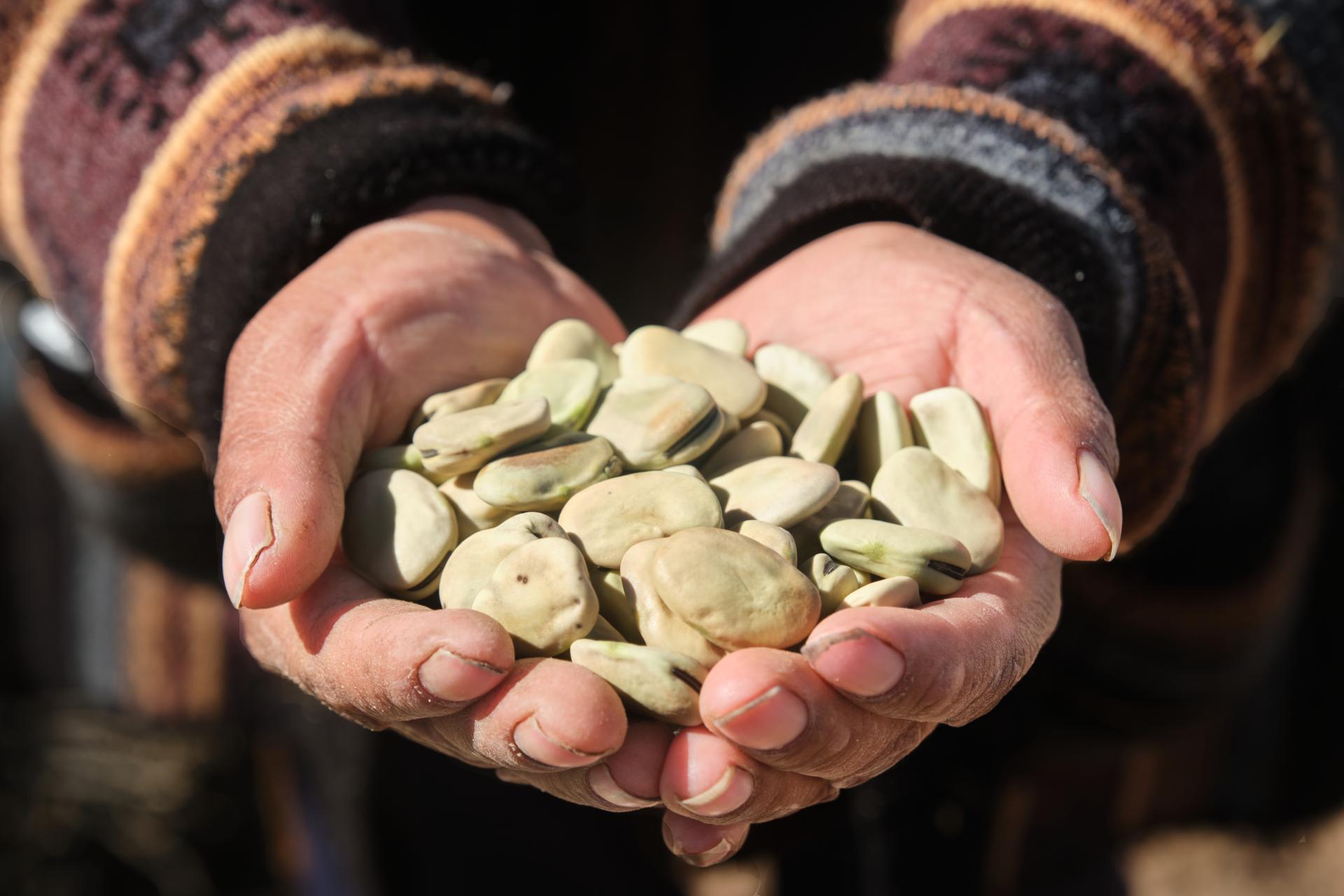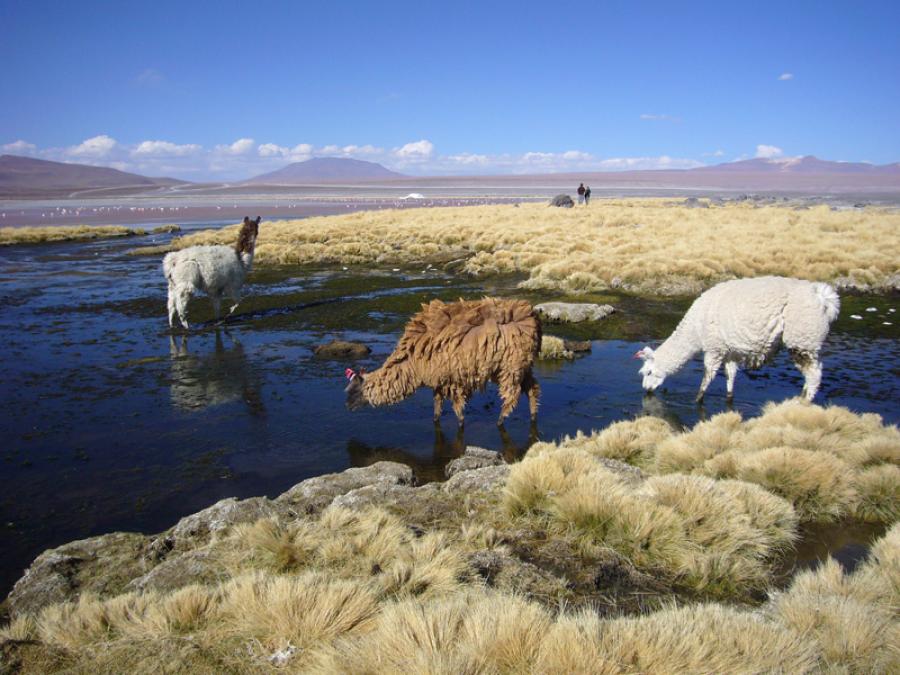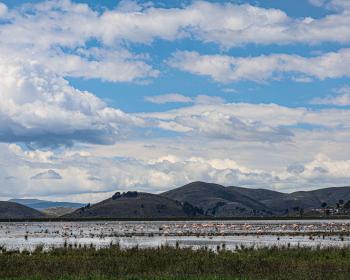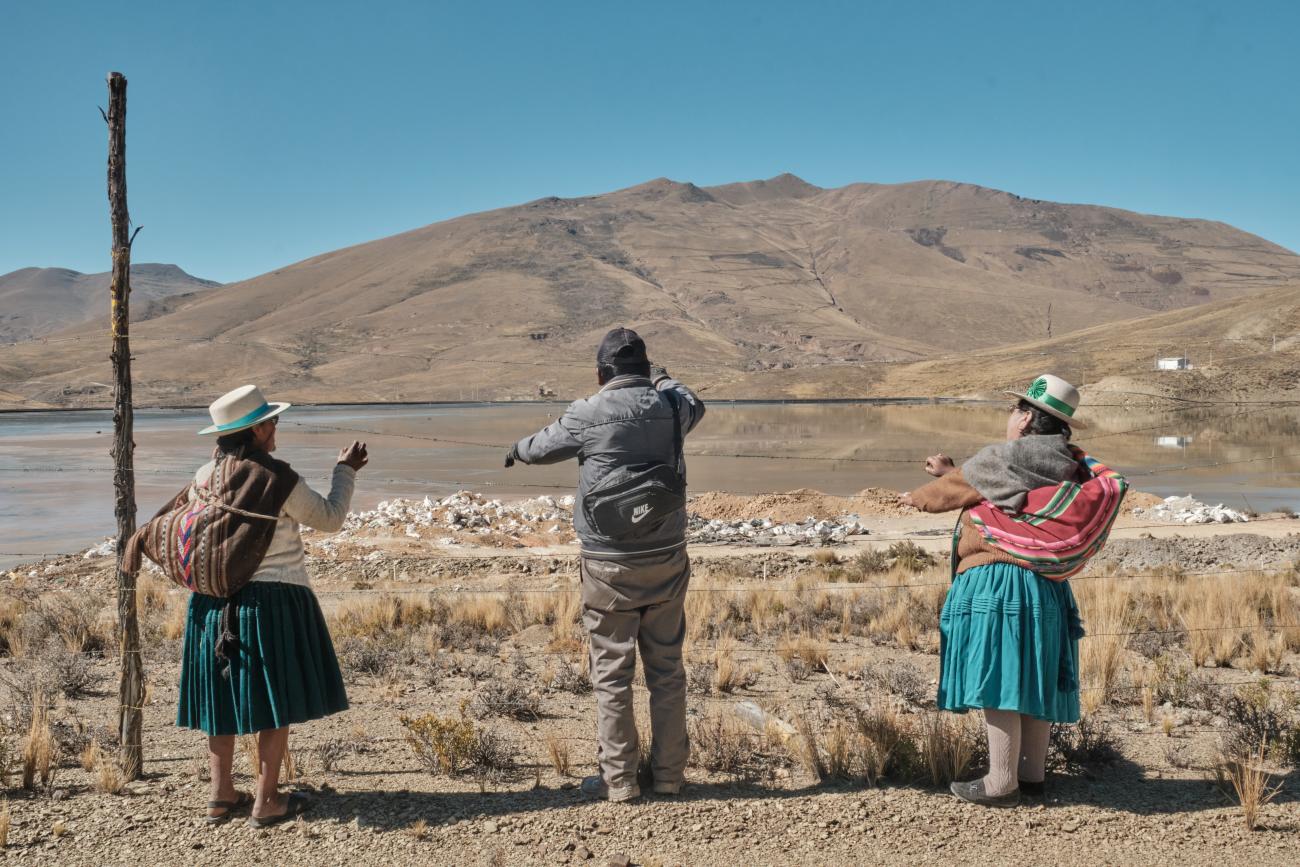
By Brandi Morin (Cree/Iroquois)
Photos by Julien Defourny
The morning air cuts sharp and thin at this altitude, carrying with it the acrid smell of industrial chemicals that has become as familiar as the mountain wind. Hernán Roque Flores (Quechua) adjusts his worn leather folder under his arm and surveys the valley below—a landscape that bears little resemblance to the verdant wetlands of his childhood. Where llamas once grazed beside crystalline streams, smokestacks now pierce the cobalt sky, belching toxic clouds across the jagged peaks of the Bolivian altiplano.
At 54, Flores has witnessed the systematic destruction of his ancestral homeland in the Ayllu Acre Antequera, a confederation of eight Quechua communities that have farmed these highlands for generations. What was once an oasis of agriculture in Bolivia's arid western plateau has become ground zero for one of South America's most devastating examples of extractive colonialism—a cautionary tale of Indigenous rights violations that has drawn international condemnation and prompted intervention by United Nations human rights experts.
"It used to be way better because at least we had water in those times," Flores reflects, his dark eyes scanning the barren slopes where his people once cultivated potatoes, barley, and quinoa. "The rivers would still have water ‘til this time of the year."
Now, in every direction from the small mountain town of Antequera—the epicenter of the mining boom—industrial infrastructure dominates the horizon. The Bolívar Mine, jointly owned by Canadian company Santa Cruz Silver Mining Ltd. and Bolivia's State-run mining corporation, has excavated 450 meters into the earth, creating a massive pit that floods with groundwater the company cannot control. The operation consumes 800,000 liters of water daily while discharging 80 liters of contaminated wastewater per second into the Antequera River—far exceeding the limits of its lease agreement.
The Making of an Unlikely Defender
Flores grew up in Queaqueani Chico, a small community within the larger Ayllu confederation, but spent much of his youth in Antequera proper. With his compact frame, cropped black hair, and weathered hands that speak to decades of farm work, he carries himself with the quiet dignity of someone who has learned to navigate between worlds. The leather folder he clutches contains a meticulous collection of legal documents, environmental reports, and photographic evidence—the arsenal of a self-taught advocate who has been forced to become something like a lawyer to defend his People's survival.
"So, he's not a lawyer," Flores’ translator explains during our interview, conducted in a mixture of Spanish and Quechua. "But thanks to the association and training they received, they got certified in Indigenous Peoples Justice."
That certification has proven essential as Flores leads the Justice Council of the Ayllu Acre Antequera, representing all eight communities in their David-versus-Goliath struggle against mining giants. The confederation includes the communities of Chapana, Antequera, Charcajara, Huacuyo, Queaqueani Grande, Queaqueani Chico, Totoral Grande, and Totoral Chico, with a combined population of 3,264 people whose way of life spans back centuries.
The transformation didn't happen overnight. Mining operations first began in the region in 1810. As a youth, Flores worked alongside his father, who held traditional authority in the community. As environmental degradation accelerated through the 2010s, leadership passed to the younger generation. By 2018, it became impossible to ignore what was happening.
"We noticed that the water was starting to become scarce, and we also noticed the pollution. So we went to one of the mines to see what was happening, and then they took me to jail," Flores recalls.
The seed is a bearer of hope, containing knowledge passed down through generations. It is the embodiment of the symbiosis between humans and the Earth.
Criminalized for Defending the Land
That first arrest in 2018 would prove to be just the beginning of a campaign of intimidation and violence designed to silence Indigenous resistance. Flores was initially charged with trespassing on mining lands, but while in custody, police allegedly planted drugs in his backpack—a common tactic used to discredit Indigenous leaders throughout Latin America.
"Initially, they charged him for invading the lands, but while the charges were being processed, they framed him for having cocaine in his backpack," the interpreter says.
Though Flores spent 15 days in jail, the charges were ultimately dropped due to lack of evidence. But the experience taught him a harsh lesson about the lengths to which the mining interests would go to protect their operations. It also strengthened his resolve and connected him with organizations like the National Council of Ayllus and Markas of Qullasuyu (CONAMAQ), a Bolivian confederation representing traditional highland Indigenous communities, which began providing legal training and support to communities facing similar struggles across Bolivia.
Over the years, multiple criminal accusations have been filed against Ayllu authorities and community members. The pattern is clear: anyone who speaks out against the mining operations faces the prospect of criminalization, job loss for family members employed by the mines, or worse.
Witnessing the environmental devastation on the ground provides a visceral understanding of what industrial mining has wrought in this fragile high-altitude ecosystem. Technical reports confirm the presence of arsenic, lead, cadmium, zinc, and cyanide sulfates in local water sources at levels exceeding Bolivia's maximum allowable limits—contamination that can cause serious neurological damage, cancer, and developmental disorders.
In this arid region, where annual precipitation barely sustains traditional agriculture, the mining operations' massive water consumption has been catastrophic. Many families have been forced to sell their llamas, alpacas, and sheep. These livestock represent not just economic security, but cultural identity stretching back to pre-Columbian times.
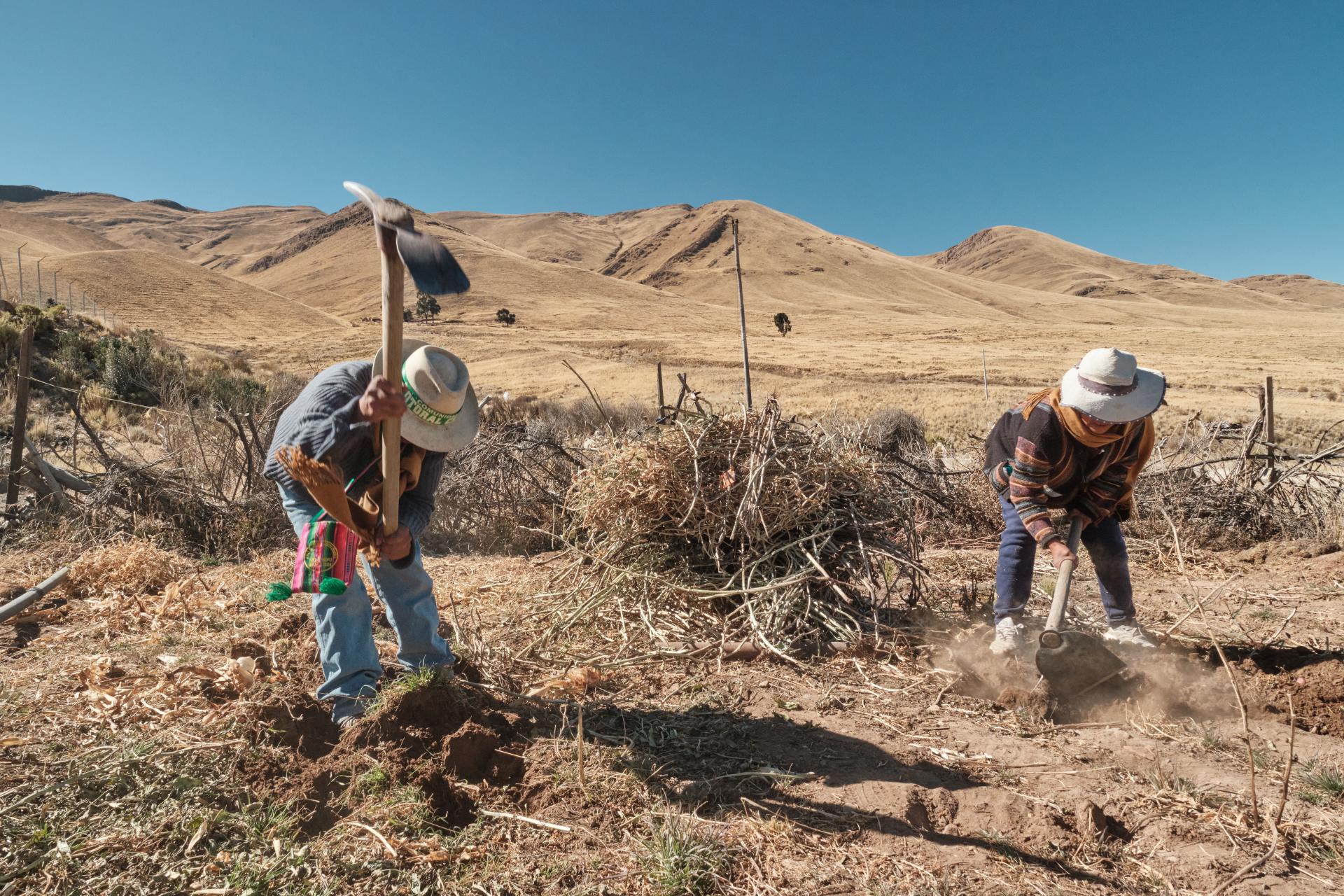
In recent years, the land has become severely dry as a result of the mining industry's use of groundwater reserves. Only a few families survive on small plots of land that are a tiny fraction of their ancestral territory.
"Livestock are of vital importance for the livelihoods of the families, and their removal is destructive to their food and economic sovereignty," notes a 2023 report by Cultural Survival and Association of Indigenous Originary Peasant Peoples QHANA PUKARA KURMI submitted to the UN Committee on the Elimination of Racial Discrimination, which has previously documented the crisis and petitioned international human rights bodies on behalf of the Ayllu communities.
The impact extends far beyond immediate environmental damage. As traditional territories become uninhabitable, families are forced to migrate to urban areas, severing the intergenerational transmission of Quechua language, agricultural knowledge, and spiritual practices tied to specific sacred sites. Young people leave for cities, unable to return to contaminated homelands, while Elders find themselves isolated from the community networks that have sustained them for decades.
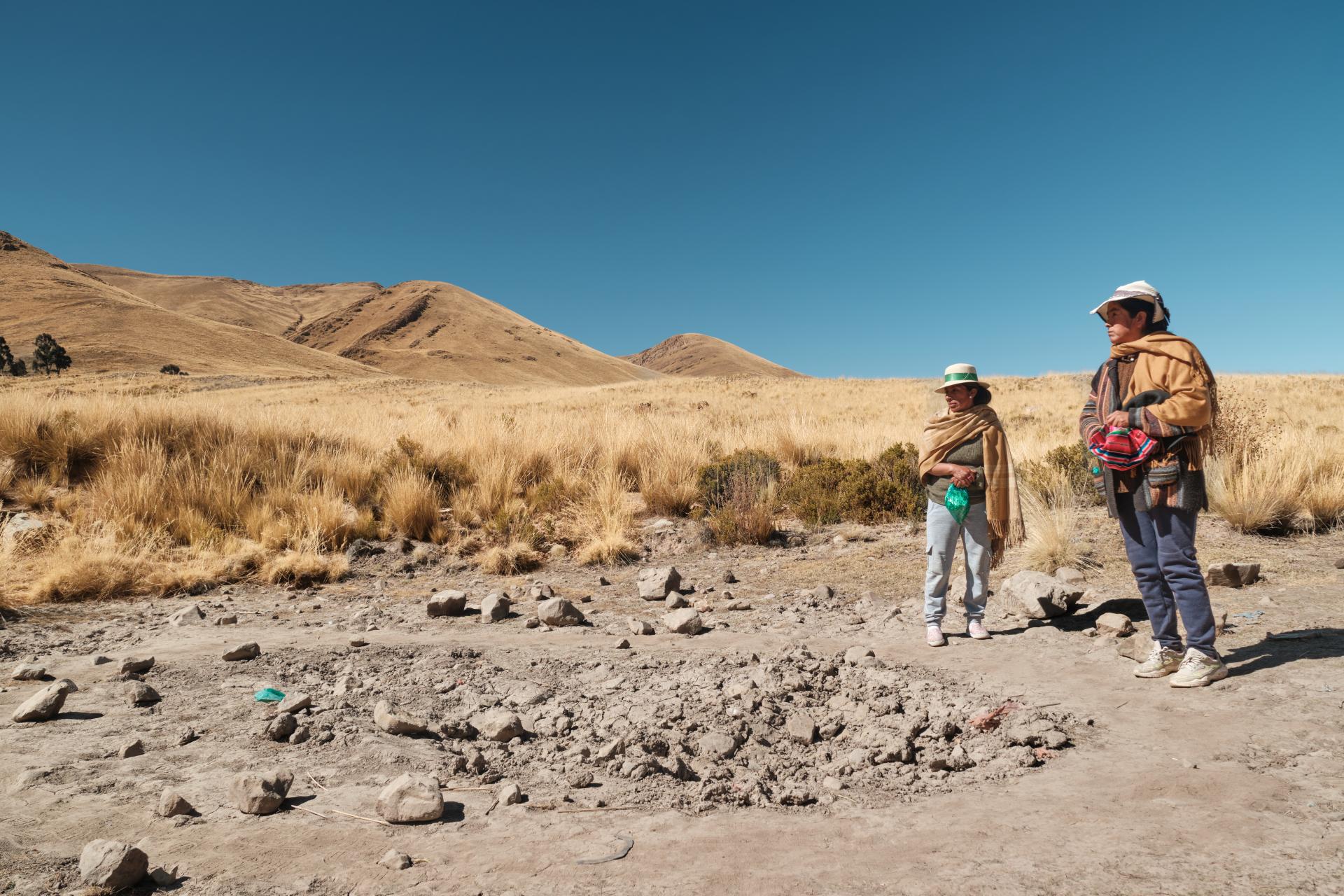
A completely dried-up water reserve. At this time of year, the water should normally be flowing.
"Forced migration resulting from the devastation of the territory separates youth from the Elders of the community, thus preventing participation in shared cultural activities and the inheritance of cultural knowledge," while "a decrease in the birth rate within the community further threatens the transmission of culture. All of these impacts present a risk of permanent cultural extinction," the Cultural Survival report explains.
The Day Terror Came
The most dramatic confrontation came on June 7, 2022, when Flores and other community leaders organized a peaceful vigil to pressure mining companies to address environmental concerns. After nearly a month of protests, Oruro department authorities promised to conduct environmental inspections. The inspections never materialized.
Instead, what arrived was violence on an unprecedented scale.
"On June 7th of 2022, they came screaming: 'We want Hernán Roque, Hernán Roque's head. We want his head,'" Hernán recounts, his voice steady as he recounts the traumatic memory.
Approximately 1,200 mining workers and union members, armed with dynamite and incendiary devices, descended on the vigil sites. The attackers physically assaulted women protesters, threatened them with sexual violence, and destroyed the communities' sacred symbols. They burned everything they could find and stole valuable personal belongings before disappearing back to their mining camps.
Flores was at one of two blockade points when a community member called to warn him of the approaching mob. "We were three groups that divided. Some of them went to the river, others to the mountains. We just had to lay low until the whole thing was over," he recalls.
From his hiding place in the mountains, Flores could see smoke rising from the destroyed encampments. "It was terrible because hearing that they're saying 'we want your head' is terrifying. If they had found me, I don't know what could have happened, because we were like 30 people against a thousand of them."
The attack achieved its intended psychological impact. Many women survivors have not returned to their territories due to ongoing fears about security. Criminal complaints filed by community members have gone nowhere, and victims fear reprisals for speaking out.
The crisis in Ayllu Acre Antequera has drawn scrutiny from international human rights bodies, most notably the UN Committee on the Elimination of Racial Discrimination. In December 2023, the committee published a scathing review of Bolivia's human rights record, making specific mention of the Quechua communities' situation.
The Committee expressed concern about "allegations regarding the granting of licenses for mining and hydrocarbon exploitation and the development of infrastructure projects with the potential for soil contamination and impact on the traditional livelihoods of these Peoples, without systematically holding consultations to obtain the Free, Prior and Informed consent of the affected populations."
This principle of Free, Prior and Informed Consent (FPIC) is guaranteed by international law, including the UN Declaration on the Rights of Indigenous Peoples, which Bolivia has officially adopted. The country's constitution even includes Article 256, which states that international treaties and declarations ratified by Bolivia take precedence over domestic legislation.
"Bolivia is part of these treaties and declarations," Flores emphasizes, pointing to his well-worn copies of the relevant documents. "The constitution has to be compliant."
Yet, the gap between legal theory and reality remains vast. The Bolívar mining contract was signed without any consultation with the affected communities, and despite clear evidence of environmental violations and human rights abuses, operations continue to expand.
Flores says the expansion of extractive industries has accelerated under governments that claim to represent Indigenous interests. Former President Evo Morales (Aymara), Bolivia's first Indigenous head of state, positioned himself as a defender of Pachamama while simultaneously opening vast territories to foreign mining companies.
"Evo Morales has always said he identifies as an Indigenous person, but in truth, his actions do not show he's an Indigenous person," Hernán says. "His government has even been more neoliberal than the previous governments because what he does is give their lands to these international corporations."
This critique reflects a broader tension within Latin American progressivism between the rhetoric of Indigenous rights and the economic pressures that drive governments toward extractive development models. Bolivia's economy remains heavily dependent on mining exports, creating powerful incentives to prioritize short-term revenue over long-term environmental and social costs.
For Flores, the current struggle represents the third generation of his family's fight for land and water rights. His grandparents led the first generation's successful campaign to gain legal title to community territories in the 1950s and ‘60s. His father continued the struggle for water rights and community autonomy. Now, Flores carries forward a legacy of resistance that has evolved to meet new threats.
"This is a fight," he explains. "After my dad died, I had to take charge in his duty. And thanks to the constitution, these articles and international treaties, that's how I got the courage to keep fighting, because we are protected by these treaties, even though the government might not fulfill them. I feel protected because there's this legal framework."
That sense of legal protection, however tenuous, provides crucial psychological sustenance in the face of overwhelming odds. International law offers a language and framework for resistance that transcends the immediate power imbalances of local politics.
Today, as Flores continues to document violations and petition international bodies for intervention, the communities of Ayllu Acre Antequera face an uncertain future. Of the original 1,500 community members, only about 50 remain to work in the mines—a costly compromise that provides income while accelerating their homeland's destruction. The rest have either fled to cities or struggle to survive on increasingly marginal land.
The mining contract is set to expire in 2028, but Flores argues it should be voided immediately due to repeated violations of environmental and social obligations. "Justice for me is that they [governments] just fulfill the national constitution, because there are different articles that defend our rights," he says simply.
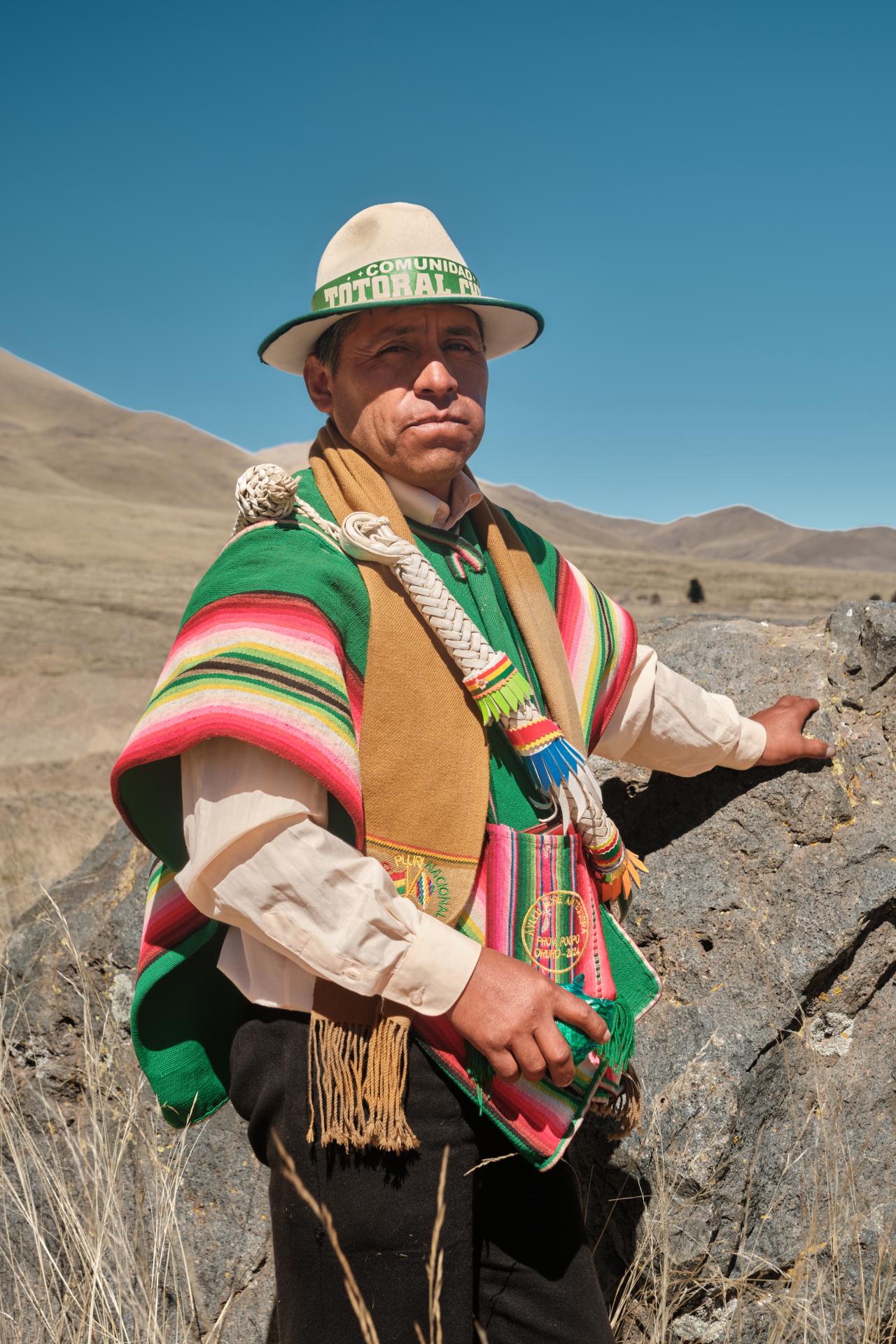
Brian Pedro Ventura Tata, the authority of the Totoral Chico community.
Prisoners in Their Own Land
Minutes up the mountain road from Flores’ community lies Totoral Chico, where Brian Pedro Ventura Humerez Tata leads a community under siege. Tata cuts a dignified figure in his traditional white fedora adorned with a green ribbon bearing his community's name. His green poncho with colorful sleeves speaks to cultural pride maintained despite overwhelming pressure. But beneath the traditional dress lies the weight of a man watching his world disappear.
"Those of us who are actually living here now, all of us are almost 110 people," Tata explains, describing how his community has shrunk from nearly 300 people who once lived off cattle, sheep, and llama herding. "Before that there were more people, because everyone had their cattle."
The miners and their families have essentially colonized Totoral Chico, creating a parallel society that discriminates against the original inhabitants. Where children from both communities once might have played together, now there's stark segregation. A large soccer field constructed during Morales' presidency sits in the community center, but Indigenous children are barred from using it.
The environmental destruction offers a glimpse into the future facing other communities. The river that runs next to the settlement flows a rusty brown color—contamination from mining waste that companies dump with impunity. Garbage piles accumulate in spots where mining families dispose of their refuse, transforming what was once pristine highland landscape into an industrial dumping ground.
"There are no water sources left," Tata explains. "Just one water source up on this mountain next to the community, but it's guarded by the miners who threaten violence if we try to access it."
The community members still living in Totoral Chico have portable plastic water tanks perched in their yards. It is their only source of fresh water, trucked in once a week.
The monopolization of the last clean water source represents a stark example of how mining operations have inverted traditional power relations. Indigenous people who have stewarded these lands for centuries now require permission from recent settlers—outsiders to the community—to access water their ancestors considered sacred.
The surveillance is constant and oppressive. Mining families coordinate through WhatsApp networks, monitoring Indigenous community members' movements. "If they see us in a group, they'll communicate with each other, their community, and call a lot of reinforcements. And then they come with sticks," Tata says. Both men and women miners participate in these intimidation campaigns, sometimes confronting Elder Indigenous women who attempt to defend traditional gathering places.
The Destruction of Traditional Life
The cultural losses extend far beyond immediate physical threats, Tata says. Traditional celebrations that once bound the community together throughout the year have been abandoned due to economic hardship and social disruption. "This has been the worst year. Every year on the 1st of August we make this offering to Pachamama. But we couldn't do that because of the situation here," he says.
The absence of these ceremonies represents more than missed festivities. The August offering to Pachamama connects communities to ancient spiritual practices. When economic stress and social conflict make such observances impossible, the cultural fabric that has sustained these communities for centuries begins to unravel.
Traditional economic activities have similarly collapsed. Tata recalls how families once invested "two pounds of potatoes and we ended up with 60." Now, contaminated soil and water scarcity make such agricultural productivity nearly impossible.
The textile work that once brought women together—shearing sheep, spinning wool, creating intricate fabrics while sharing stories and laughter—has largely disappeared as families lose livestock and social cohesion breaks down. "Women would gather, you know, people, women would laugh. They would share," Tata remembers of gatherings that included decisions about dyeing patterns and seasonal celebrations like carnival.
Aerial view of the narrow path separating the polluted waters on the left and the supposedly drinkable waters on the right.
Illegal Operations and Official Complicity
Perhaps most galling to community leaders is the apparent illegality of many mining operations combined with official inaction. Tata points out that many miners "don't pay for working illegally. They don't have the 101 card," the permit required to transport minerals from extraction sites to processing centers.
"They don't have that card," he emphasizes, describing how mining companies operate without basic legal authorization while Indigenous communities face criminalization for defending their constitutional rights.
This illegal extraction occurs "with complicity with the mayor's office, then with the national authorities," Tata alleges. The systematic capture of local government by mining interests means that the same officials who should protect Indigenous rights instead facilitate their violation.
The creation of sham Indigenous organizations represents another insidious tactic. Mining companies have established what Tata calls "parallel agrarian unions" staffed by "foreign people who have come from somewhere else, are not really from here in the community."
These fake Indigenous organizations then conduct fraudulent consultations designed to legitimize mining expansion. "They've created these new unions like companies," Tata explains, describing how authentic Indigenous governance structures are undermined by mining-funded imposters.
Yet, even in this landscape of cultural and environmental destruction, moments of natural beauty persist. Vicuñas—graceful, wild camelids related to llamas—still run free across the high valleys and mountainsides surrounding the communities. These animals, whose soft wool was once reserved for Inca royalty, represent a connection to the land that predates both colonial conquest and industrial mining.
"Sometimes we still hunt them," Tata notes, one of the few traditional practices that continues despite the broader disruption. But for now, most of the land remains "ruined or poisoned," forcing communities to survive on small potato crops grown in whatever soil remains uncontaminated.
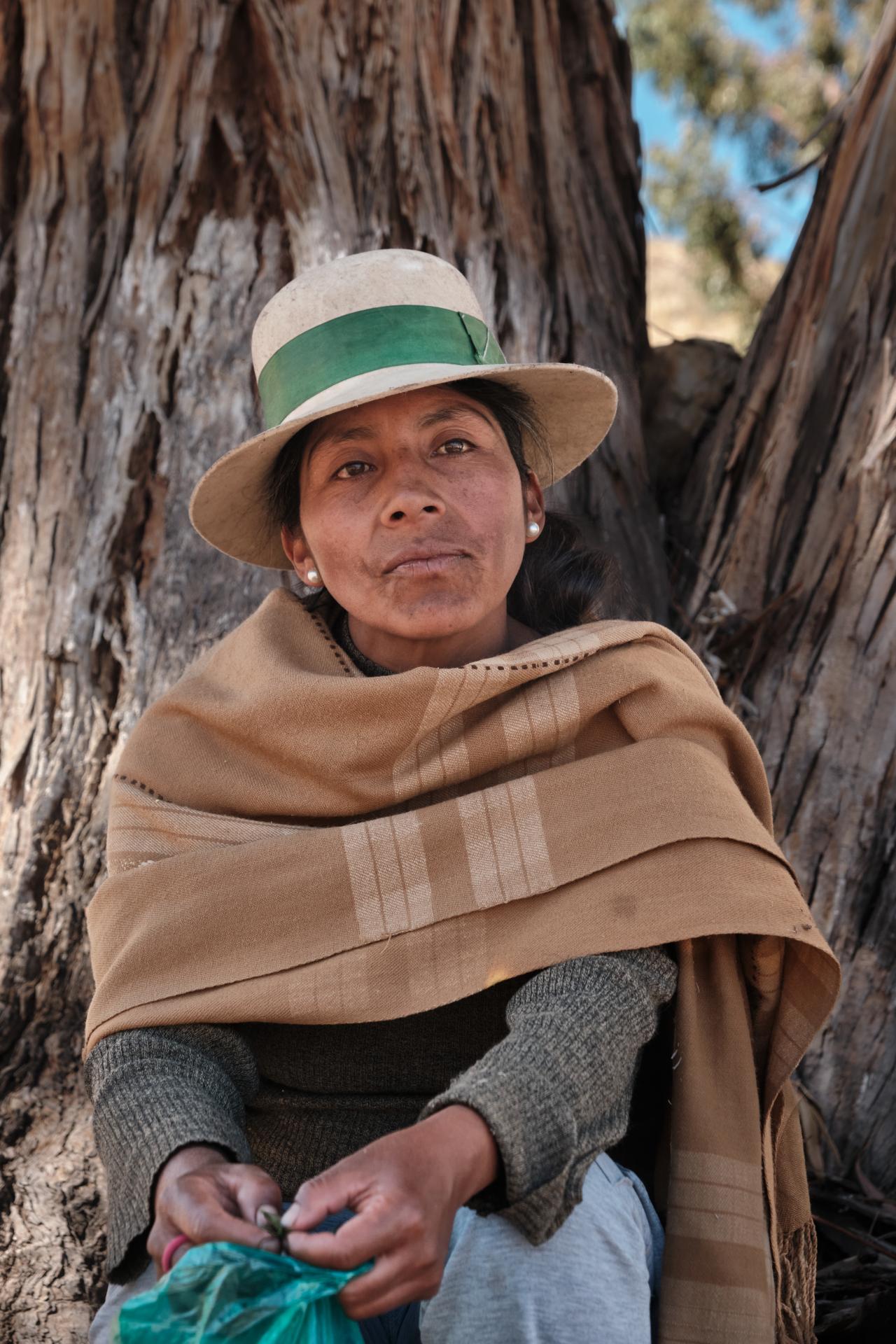
Soraida Ventura is part of her village's resistance movement. She speaks with great sadness about the multiple acts of violence she has suffered in defending the land of her ancestors. She has an unconditional love for it.
"Hope Is All We Have:" A Mother's Testimony
In Totoral Chico, Soraida Ventura embodies the resilience and anguish of a community under siege. At 39, she serves on the Council of Justice of her Indigenous community, a role that has made her a target for violence and legal harassment. When we meet, she is processing chuño, the traditional Andean method of freeze-drying potatoes that has sustained highland communities for centuries.
Tiny in stature but radiating the strength of a determined advocate, Ventura stands in a small field across from her community, her long, black hair tied behind her and tucked under a beige cowboy hat for protection from the intense highland sun. Her fingernails are packed with dirt from harvesting potatoes, a testament to the manual labor required to survive in this harsh environment.
Tears stream down Ventura’s face as she describes the daily reality of life under mining occupation. "It's tough, but we'll keep fighting," she says, her voice breaking. "As parents and community members, hope is all we have. We're tearful and sad, but we'll make it through. It's the only hope we have as humans."
The psychological toll on children is perhaps most devastating to witness. "We cry sometimes. I wake up hoping for peace. That's the only dream we have as parents for our children," Ventura continues. "It's not easy to erase the hurts our children have from our hearts and minds when they ask, 'When can we play outside? Is it safe?'"
The systematic discrimination extends even to basic services. Healthcare, education, and freedom of movement have all been weaponized against Indigenous families. When Ventura was brutally beaten by miners while defending community grazing lands, even medical treatment became a battleground. "There's a health center here where we're no longer treated the way we should be. We don't have the right to see a doctor," she says.
"Twenty people had beaten me, and because of the blows, the blood, all the wounds they inflicted on me, I needed to be treated at the hospital. The doctor came because they saw how they attacked me, but the miners reprimanded her, saying that if you were going to treat those people, there would be consequences because we can vote them out."
Aerial view of the chemical tailings dam.
Living Under Surveillance
The level of control exercised by mining interests reaches totalitarian proportions. Ventura describes a community living under constant surveillance, where basic freedoms of movement and communication have been eliminated.
"The miners set fires here to make watch points so they could watch who's coming and leaving," she explains. "They keep us hostage in our own community. Sometimes they'll check the buses, who's on the buses, who's going to the city."
This surveillance system serves a clear purpose: preventing community members from seeking help or reporting abuses to authorities outside the immediate area. The psychological impact on families is severe, particularly for children who must navigate this atmosphere of fear and restriction daily.
If that weren’t enough, the water crisis has also reached critical levels. "There's plenty of water, but the thing is, the water is already contaminated," Ventura explains. The community depends on a single remaining clean water source, but even this is controlled by mining interests. "That's the place that belongs to the community, but even the miners use it, and they're still violating our rights. We had to go to a workshop yesterday to say, 'Please give us water.' We ourselves are facing this violation of our right to water."
The environmental destruction has eliminated traditional livelihoods. Where families once raised cattle and sheep on communal grazing lands, contamination has made animal husbandry impossible. "We always walked in the mountains as well as in the plains, but with all the pollution, the veins have dried up. For humans, the vital element is water, and for animals as well, but they've dried up, and so we've had to get rid of sheep farming as well as cattle farming," Ventura says.
Even the dust from mining operations has become a health hazard. "The dust is covering all the vegetation. Our animals cannot eat that. We don't know how much more we're going to be damaged by these miners."
Legal Persecution
Like many Indigenous leaders who speak out, Ventura faces multiple criminal charges for defending her community's constitutional rights. "The mining group filed a claim against me saying that I was obstructing the work they were doing, but I wasn't obstructing anything. I was just defending my territory." She now faces legal proceedings—a common tactic used to exhaust and intimidate Indigenous defenders.
The government officials she has approached for help have proven either complicit or powerless. "We have gone to the vice minister of mining, to report to the ombudsman what illegality is happening, and we've also gone to the ombudsman so he can defend human rights," she says. "But the action has been denied, and they have taken more force."
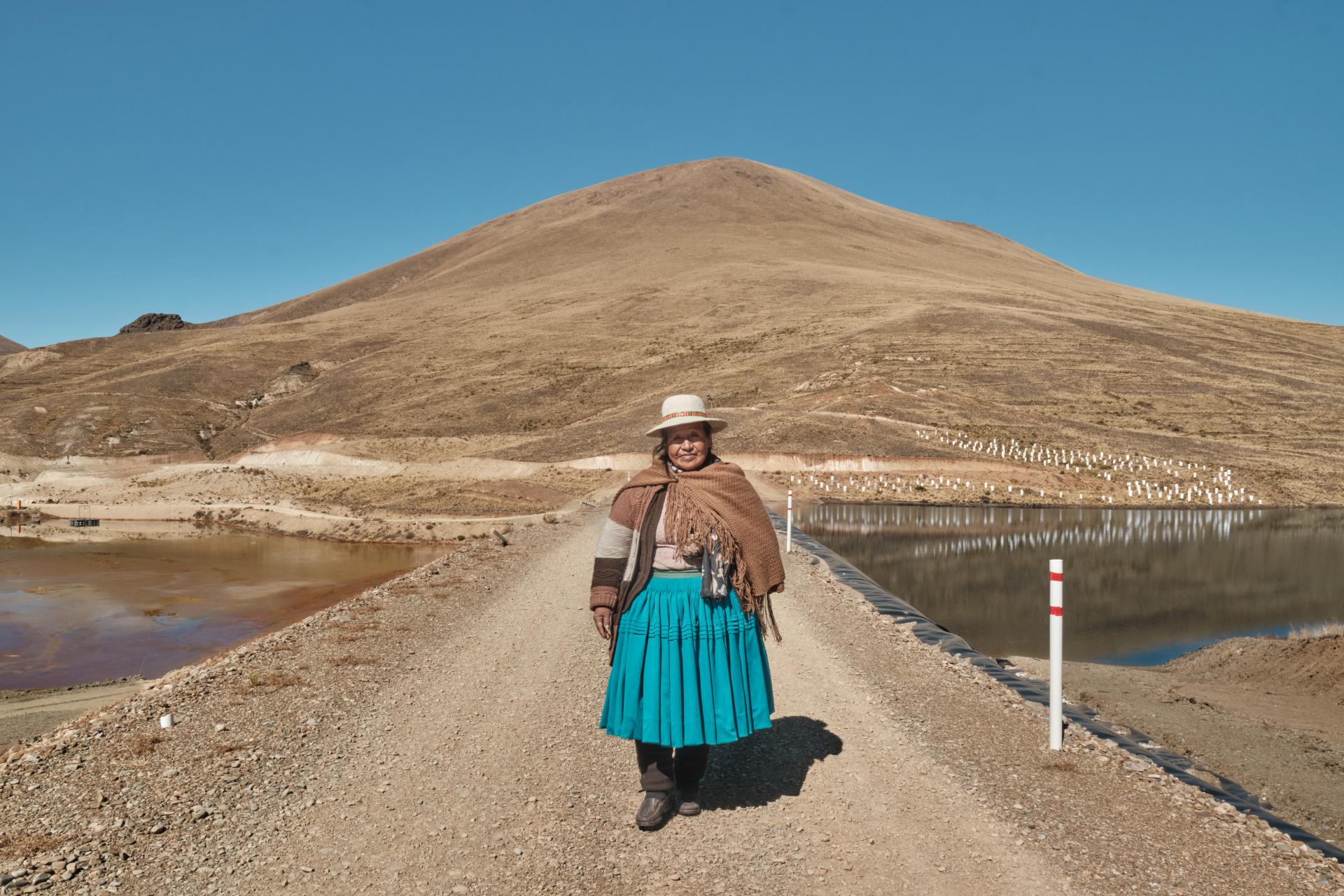
Guadalupe Fernandez is a member of the community justice council. She walks on a narrow strip of land separating, on one side, the polluting waste from the mine and, on the other, the water that should be consumed by the people and livestock of her community.
"They Were Screaming They Would Rape Us:" An Elder's Resistance
A few kilometers away in the community of Queaqueani Grande, Guadalupe Fernández prepares a traditional meal of llama meat, chuño, and highland vegetables in her small concrete home. At 60, she wears the traditional cholita clothing of Indigenous women: full tiered and puffed skirts, bowler hat, and colorful shawl that marks her cultural identity.
Fernández represents another dimension of the resistance: the Elders who remember how these territories functioned before industrial mining transformed them into sacrifice zones. Her testimony reveals how mining companies systematically manipulated communities into signing contracts through a combination of deception, economic pressure, and outright coercion.
"In 2005, they basically told us that they were going to enact violence against us if we didn't sign," she recalls. "This caused a lot of social conflict between families, between members of the community. Some sons would tell their dads, please, you have to sign this. Other people didn't know how to write, so they would only use their fingerprints to sign the contract because they were told they would get money."
The manipulation was systematic and persistent. When Fernández’s brother, who served as community secretary, refused to sign the mining contract, company representatives and community members who supported the mine tracked him down. "He was hiding so he didn't have to sign," she explains. "But finally they found him and they took the community stamp away from him. After that, they did whatever they wanted—they signed in favor of accepting mining in the name of the community."
The pressure extended to tracking down every individual community member. "They would look for them everywhere, in different parts of the country so they could sign," Fernández says. When her own father died, Fernández was the one who had to sign. There was a lawyer who would come daily to look for her.
Despite the harassment, Fernández demanded to see the actual contract before signing—something most community members were denied. "The people who signed first, they never gave them the contract," she says. When she finally signed under pressure, she discovered the document was structured as a concession rather than a sale, because the company knew they were operating on Indigenous territory.
The promised benefits never materialized. "Once they finished the treaty, they never complied with it. If people from the community wanted to work there, they had to go and ask. It was like begging for scraps."
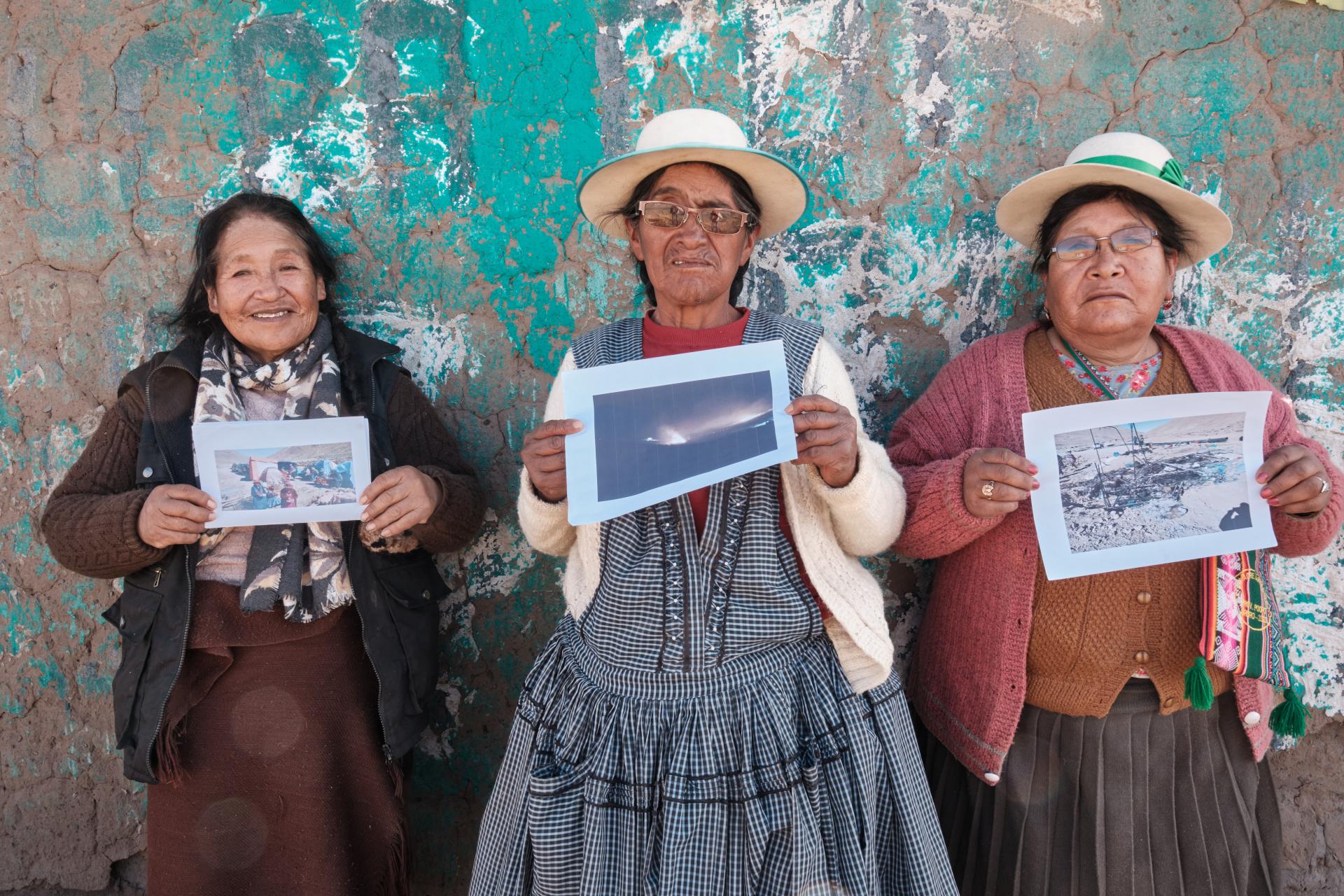
Three women, Guadalupe Fernandez, fellow community member, and Dominga Fernandez, from the Queyaqueyani community share photos of an event that marked their lives. During a protest on June 7, 2022, miners attacked their tent and burned everything. They had to flee to escape the threat of sexual assault.
The Night of Terror: June 7, 2022
Fernández's most harrowing testimony concerns the violent attack that both she and Flores survived on June 7, 2022, proof of the systematic nature of the assault and the gender-based violence that was central to the intimidation campaign. On that date, community leaders were called to a meeting in Poopó with government authorities who promised to send mining and environment ministry officials to address their concerns.
"We made a blockade for 10 days in 2022 because of the pollution and the lack of water sources," she recounts. "Meanwhile, the miners knew that most of the strong people were away from the communities, and they went to the communities where there were mostly women. At 7:00 p.m., hundreds of miners arrived with cars. They were shouting, throwing dynamite and firecrackers. They seemed to be really drunk."
The gendered nature of the violence was explicit and terrifying. "They were screaming at the women: 'You have to get out, you whores, you come out, you have to open your legs.' They said really bad things," Fernández recalls, her voice heavy with the memory.
Fernández hid behind a log in the river while the miners burned the tents and belongings at the blockade site. "We had to escape because they came with dynamite. We were scared and everyone dispersed. Some were hiding in the mountains and others in the river," she says.
The attack achieved its objective: many women, including Fernández, were traumatized by the explicit threats of sexual violence combined with the use of explosives near civilian encampments that included children and Elders.
Environmental Crimes in Plain Sight
The mining companies, including the Canadian-owned Bolívar mine, dispose of toxic waste in full view of communities while simultaneously eliminating access to clean water. Fernández leads us to a tailings dumping area where mining waste is deposited directly adjacent to the only remaining water source. Only a narrow dirt road piled up on a man-made hill separates the toxic dumping ground from the so-called fresh water source.
"The miners told us to water our livestock in a water hole directly parallel to the tailings pond because there are no fresh water sources left," she says, describing an arrangement of environmental racism: Indigenous communities are forced to choose between death by dehydration or slow poisoning through contaminated water.
The proximity of the tailings to the water source makes clear that contamination is inevitable, yet mining companies present this as a solution to the water crisis they themselves created. "When we go and report that the water is contaminated, the miners say, 'Okay, we have the water source here so your animals can drink it.' But the water is still polluted because of the chemicals and dust," Fernández says.
Despite facing criminal charges, physical violence, and environmental destruction, Fernández's commitment to resistance remains absolute. In 2011, she organized a 10-day blockade that resulted in criminal charges against her for allegedly blocking public services and threatening security. Though the charges were eventually dropped after community pressure, the experience taught her that legal harassment is simply another tool of intimidation.
"You get persecution when you try to fight for your rights," she says matter-of-factly. But this knowledge has not deterred her. In April 2025, she traveled to New York to testify before the UN Permanent Forum on Indigenous Issues about the violations occurring in her territory, bringing international attention to a struggle that Bolivia's government prefers to keep hidden.
Yet, even thousands of miles away from home, Fernández experienced the nightmare of intimidation. She says she was threatened and harassed by Bolivian authorities attending the forum, who went as far as erasing her name from the list of speakers.
"I will not stop resisting," she declares from her small kitchen, the smell of traditional foods filling the air. "I will always fight for justice for myself and the surrounding communities, even if they threaten us with dynamite and violence."
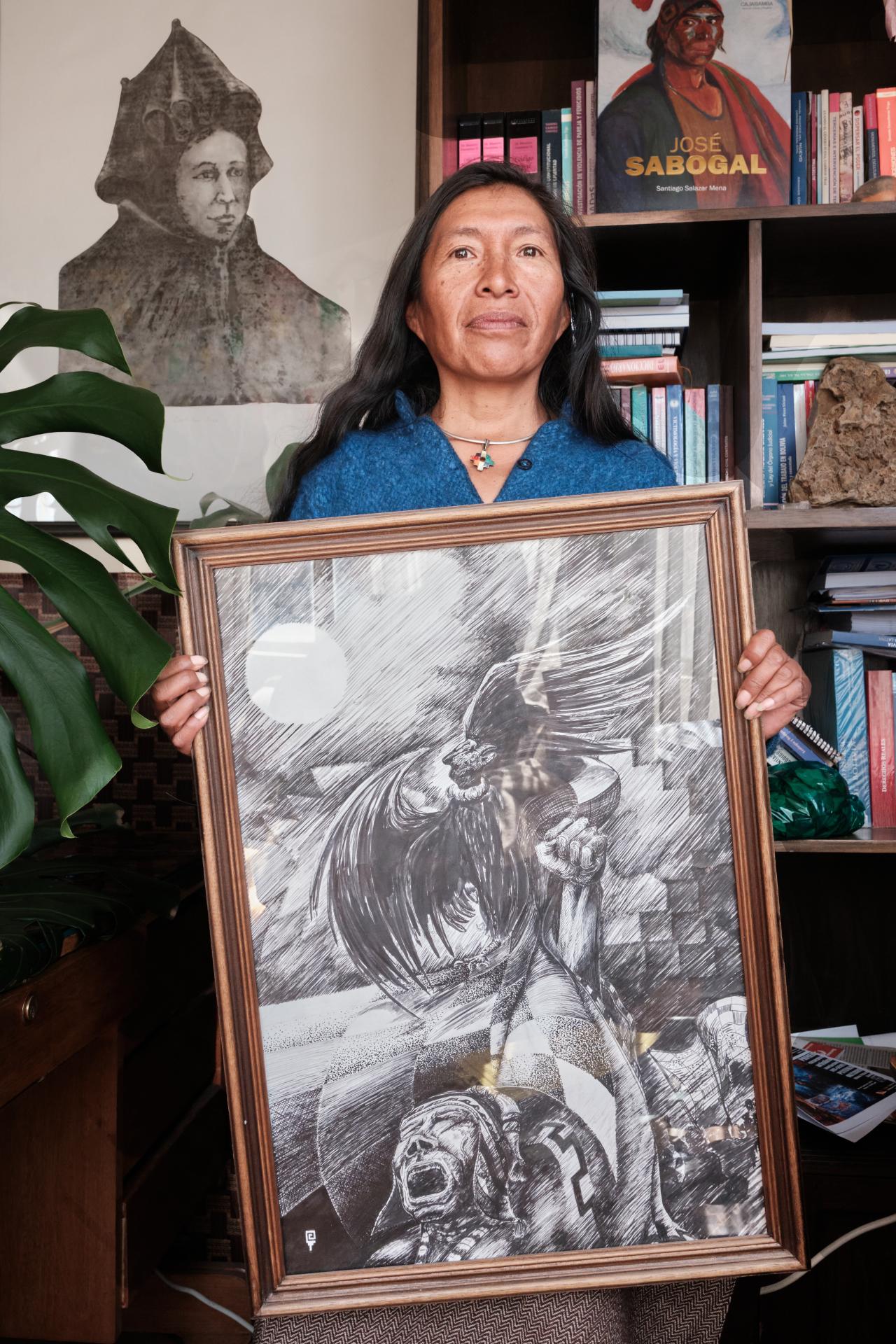
Beatriz Bautista is a lawyer in La Paz. With this painting in hand, she carries the soul of Latin America, the cry of the people brandishing the condor (the emblem of South America).
The Legal Expert: "It's Still a Colonial State"
In her office in El Alto, the sprawling Indigenous city that overlooks La Paz, Beatriz Bautista (Aymara) provides the legal and historical framework that helps explain why Indigenous communities face such systematic violations. At 52, she is an Indigenous lawyer, philosopher, and human rights defender who has dedicated her career to supporting communities affected by extractivism.
Bautista's path to legal advocacy began with personal experience of discrimination that marked her childhood. When her family migrated from rural areas so she could finish high school, she witnessed her mother's suffering firsthand. "When they took her to the hospital, they didn't accept her even though they had the insurance because of discrimination," she recalls. "For me, it was very hard to see this attitude towards Indigenous people [of] racism and discrimination, as if Indigenous people wouldn't have rights, as if they wouldn't see them as humans."
After studying Indigenous philosophy at Bolivia's first Indigenous university—which was closed by Morales' government in 2006—Bautista earned her law degree with a specialty in Indigenous Peoples' rights. In 2018, she co-founded the Association of Indigenous Originary Peasant Peoples QHANA PUKARA KURMI, which now supports over 100 Indigenous communities across Bolivia facing extractive pressures.
"As Indigenous people we are preexistent to all these colonial nations, [yet] the government has the power to take away our land from us and give it to international companies," Bautista says, noting that the mining conflicts of today occur amid a context of centuries of resource extraction. "All the silver was extracted and delivered directly to Spain, and that's why Europe became so rich—because all the minerals came from Bolivia."
These rights violations go to the core of Indigenous existence. "The right to territories is key because any Indigenous people without their territory won't exist," she explains. "The violation of these rights is attempting genocide against our own existence, against the generations to come."
Bautista's work has made her a target. "I have been hit. The government threatened our association and they closed our office doors. The threats are constant. It's very difficult to access Indigenous territories because the miners know who we are," she says.
For Bautista, Bolivia remains a colonial state that "won't acknowledge the rights of Indigenous people and their territories," regardless of constitutional guarantees or international treaties. Despite the odds, she remains committed: "Even if the miners have so much power, that doesn't mean we won't keep fighting."
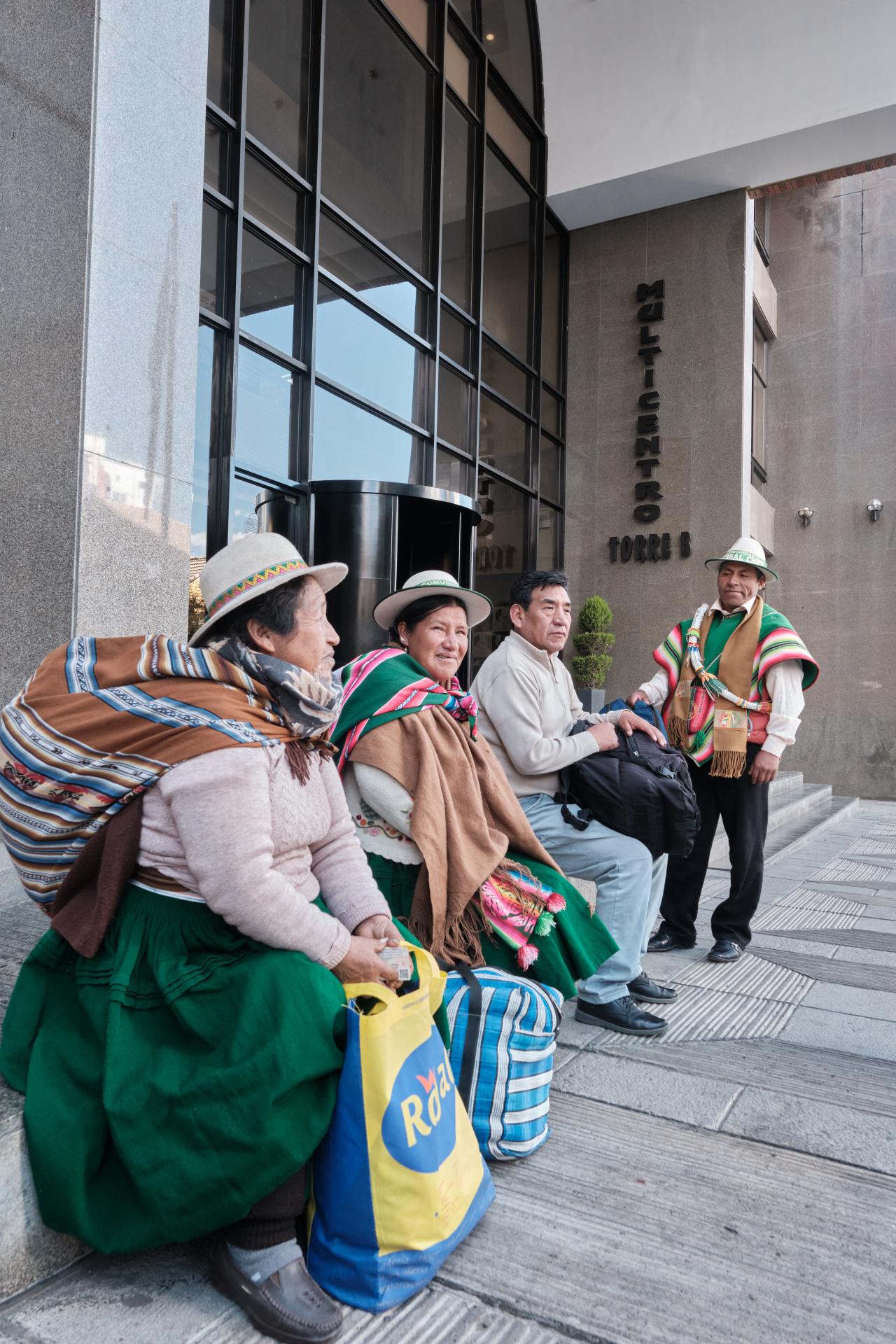
Several community members are waiting in front of the buildings in La Paz to interview the mining companies responsible for the destruction of their land.
International Pressure and Corporate Accountability
The crisis in the Ayllu Acre Antequera has drawn international attention to the operations of Canadian mining company Santa Cruz Silver, which acquired the Bolívar Mine from Swiss giant Glencore in 2021. The underground silver-zinc-lead mine, first mined in 1810, operates under a profit-sharing agreement where Santa Cruz receives 45% of profits while the Bolivian government gets 55% through its partnership with the state-owned Mining Corporation of Bolivia (COMIBOL).
In September 2024, Indigenous leaders from the Ayllu Acre Antequera, together with organizations Qhana Pukara Kurmi, Cultural Survival, and Earthworks, submitted a comprehensive human rights report to Santa Cruz Silver ahead of its annual general meeting in Vancouver. The report documented violations of multiple human rights at the mine site, including the right to Free, Prior and Informed Consent, the right to health and a healthy environment, freedom of expression, safety, non-discrimination, cultural rights, and the right to belong to an Indigenous community.
The communities presented five key demands to the Canadian company: end violence and intimidation against defenders, stop criminalizing Indigenous authorities, implement proper consultation processes for Free, Prior and Informed Consent, clean up heavy metal contamination in the Antequera River, and conduct independent investigations of tailings management following reports of leaks and wind-blown toxic waste.
The report specifically noted how the mine uses "vast quantities of water and has contaminated water and land in the vicinity," with technical studies finding "elevated levels of heavy metals in the Antequera River" and community members reporting "mismanaged mine waste, known as tailings, that gets picked up and blown around by the wind."
Crucially, the report emphasized that "the Ayllu Acre Antequera was never consulted about the mine project, has not been adequately informed of the project and its impacts, and has thus not consented to move forward"—a clear violation of international standards that both Canada and Bolivia have adopted through the UN Declaration on the Rights of Indigenous Peoples.
Whether Bolivia will live up to its constitutional commitments and international treaty obligations may well determine not just the fate of eight Quechua communities in a remote mountain valley, but the country's credibility as a leader in Indigenous rights and environmental protection on the global stage.
For now, leaders like Flores, Tata, Fernández, and Bautista continue their resistance, armed with legal folders and sustained by ancestral obligations, knowing they defend something far more precious than the silver and zinc extracted from their lands.
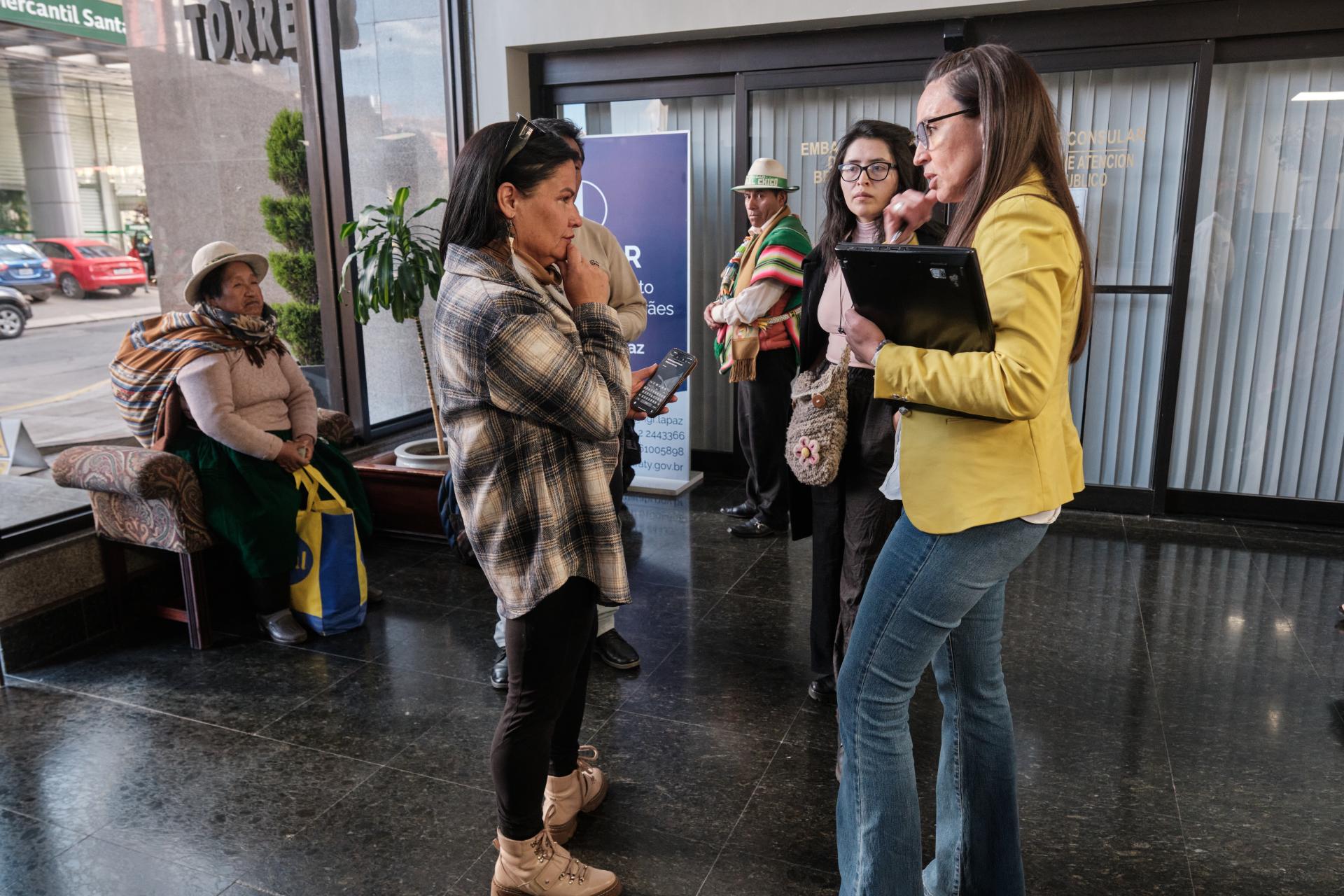
Journalist Brandi Morin questions a representative from the mining industry.
--Brandi Morin (Cree/Iroquois/French) is an award-winning journalist reporting on human rights issues from an Indigenous perspective.
The writer attempted to contact Santa Cruz Silver using the phone number provided on the company's website from its headquarters in Vancouver, but the number was not in service. The writer traveled in person to the Bolívar Mine headquarters in La Paz, which operates under the name Sinchi Wayra. After meeting with the communications director and requesting interviews with company directors, the communications director stopped responding to follow-up emails and ignored further interview requests.
The writer also visited several government ministry offices in Bolivia to request interviews, including the Ministry of Mining and Metallurgy, Ministry of Environment and Water, and Ministry of Cultures, Decolonization, and Depatriarchalization. Written interview requests were hand-delivered and officially stamped by ministry officials, a standard media process. More than three weeks later, no responses have been received from any government ministry.
Top photo: The members of the Queyaqueyani community look on in dismay at this barrage of chemicals that is now part of their daily lives. During the dry season, the toxic liquid dries up and turns to dust. The wind then carries the toxic dust to neighbouring communities.
